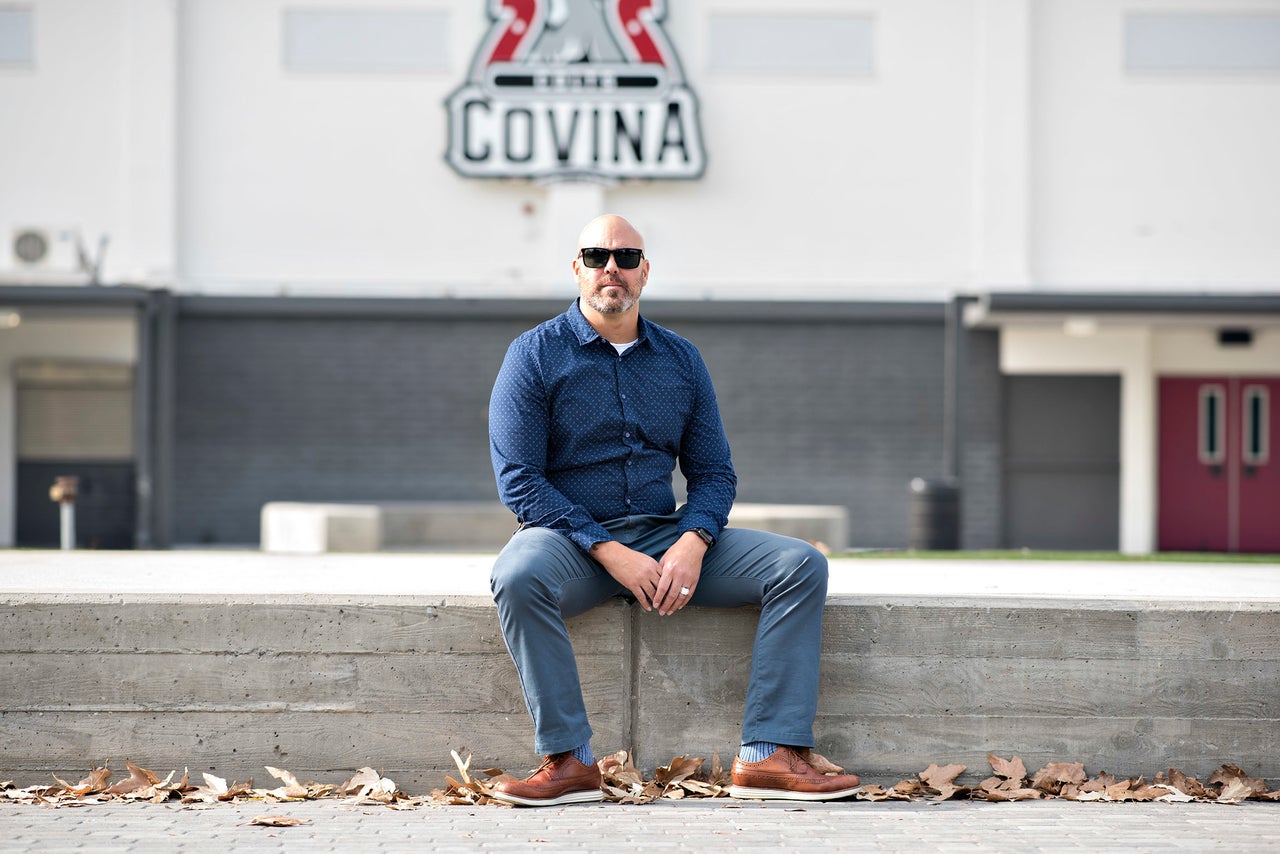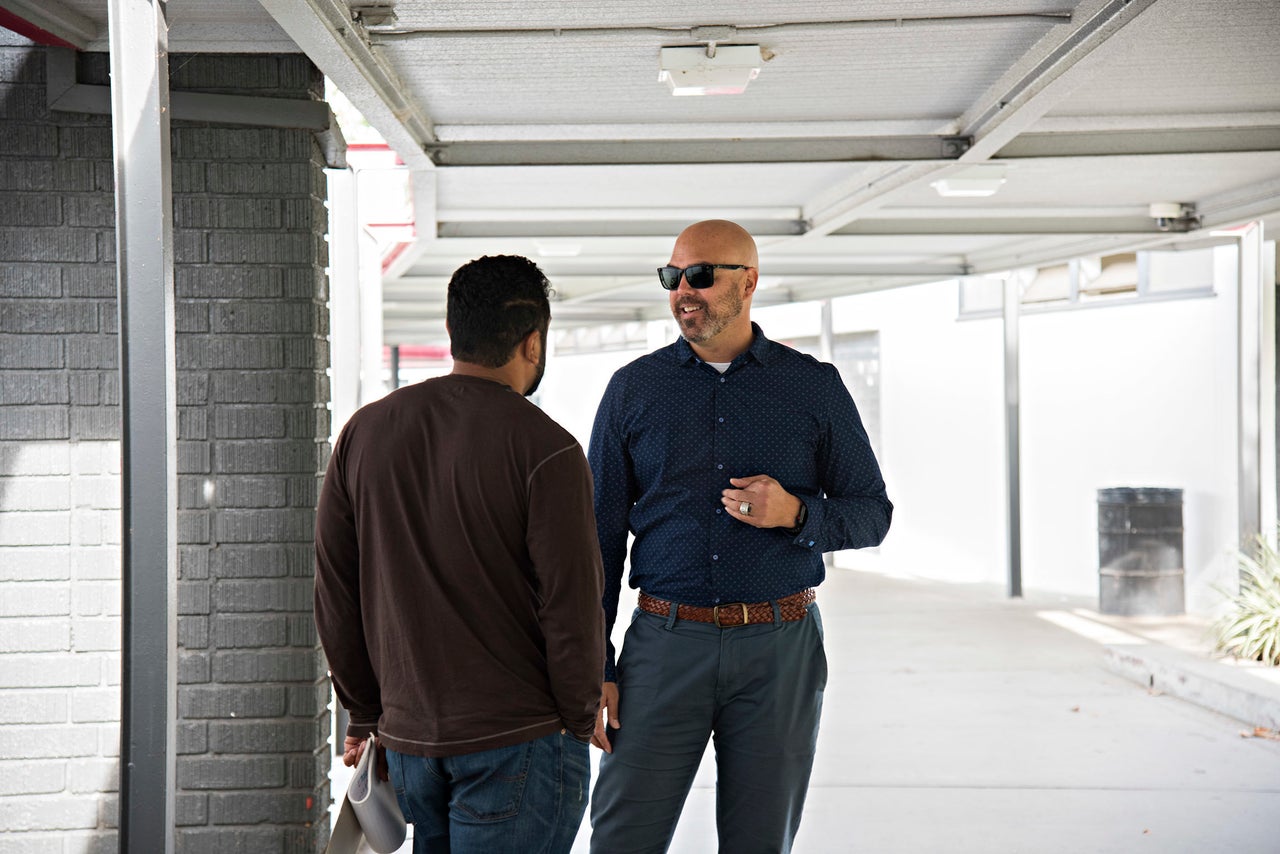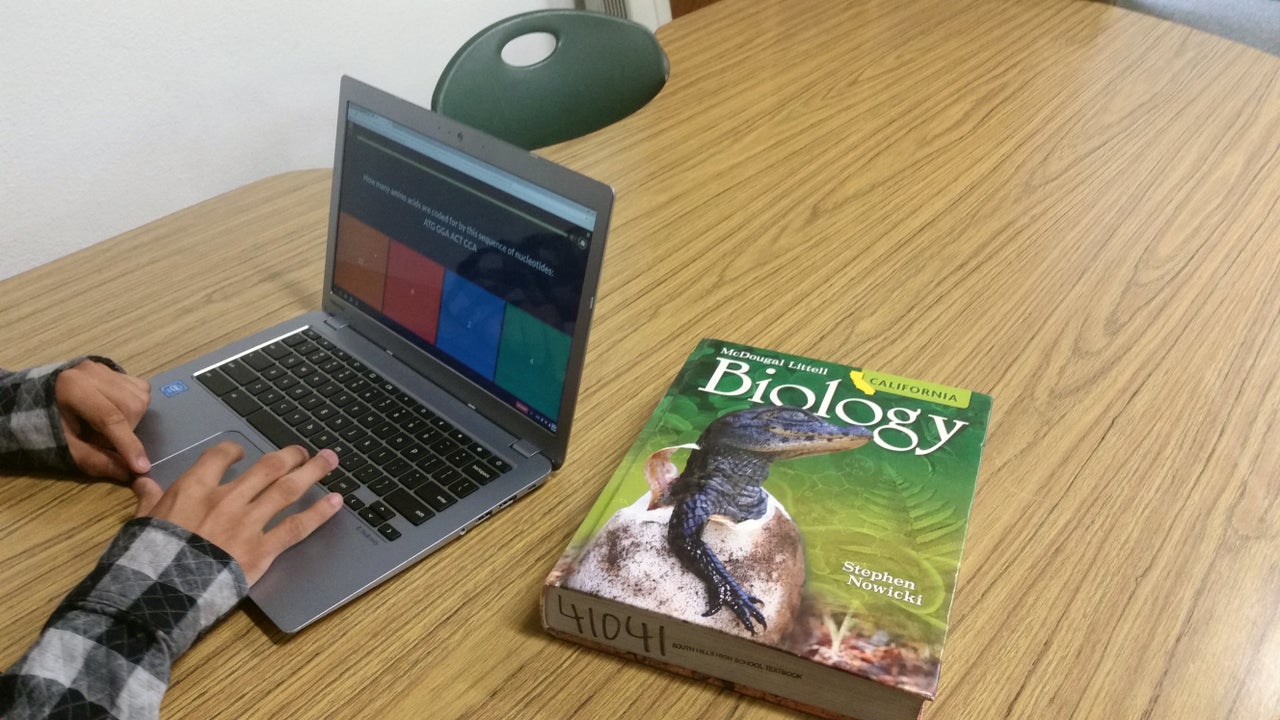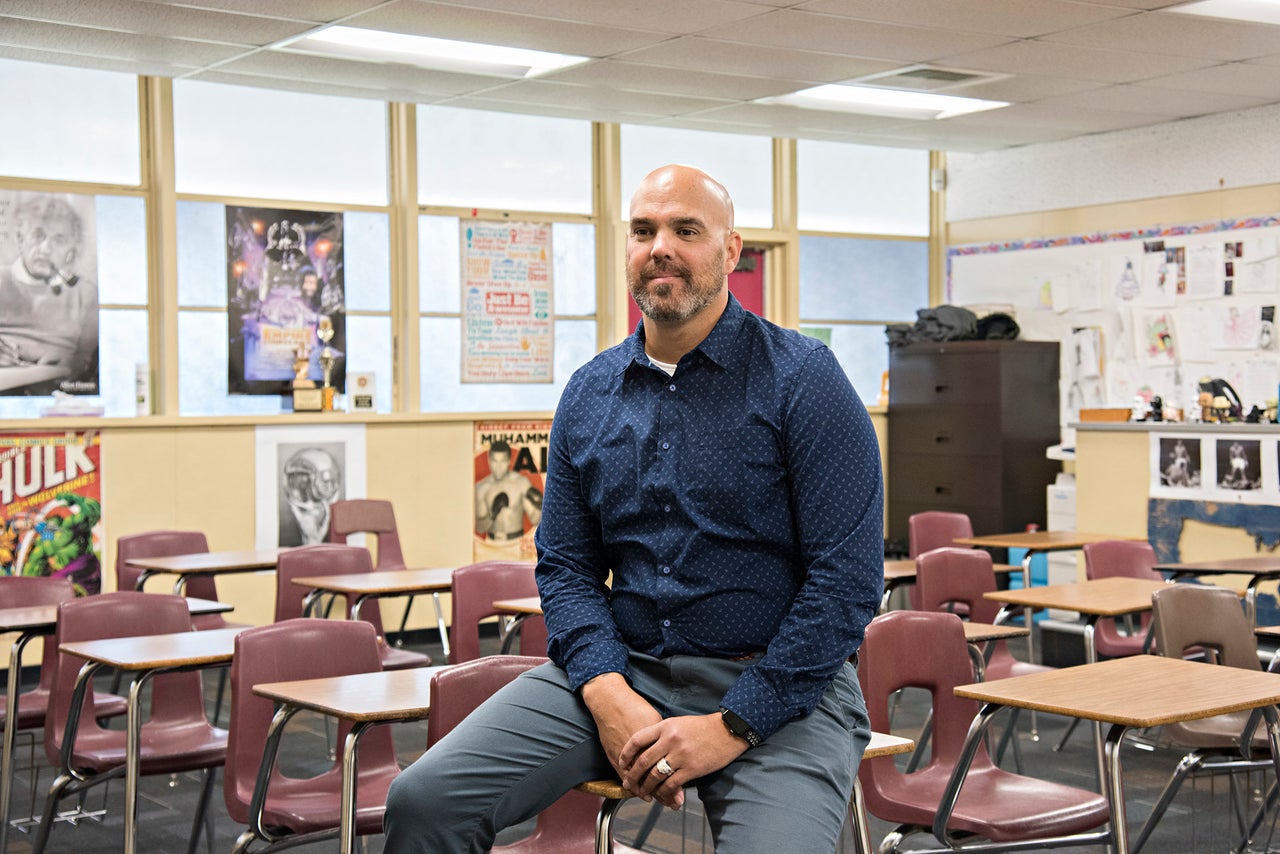COVINA, Calif. — Ryan Parry was dismayed when he started his career as a high school special education math teacher 19 years ago. While general education classrooms at Covina High School in this town in the Valley east of Los Angeles were stocked with algebra and geometry books, Parry was given a book that covered only basic math. He remembers thinking it looked like a book you’d find in an elementary school, with a picture of the numbers 1 through 9 written in the sand of a beach on the cover.
Parry said his room was a “horrible little classroom in the back of the campus that no one knew existed.” His students were constantly tardy. Eventually, they told him why: They didn’t want other students to see them making the trek over to P building, which is set off from the semi-circle of the main campus buildings. Anyone seen going there was at risk of being mocked as a “P town pimp,” students said.
Isolated from their peers and frustrated by their classes, many of Covina-Valley Unified’s students in special education left school. The district’s class of 2010 had a 73 percent graduation rate for students in special education and a 13 percent dropout rate — double the dropout rate for the student body overall.
Teachers like Parry began pushing for changes, and over the last decade district officials have worked to improve the experience of students in special education — and thus reduce dropout rates — by reducing the stigma and challenging the students more. They moved special education classrooms to be more centrally located. Special education teachers joined meetings with general education teachers. District administrators made sure the majority of students with disabilities were using the same textbooks as their peers and following the same curriculum.
“It’s a lot easier to quit something and drop out of something you don’t feel you have a connection to,” Parry said.

The high dropout rate for students with disabilities is a pressing national problem. Special education encompasses a wide range of disabilities, from severe cognitive limitations to ADHD and dyslexia. Most students’ disabilities should not preclude them from succeeding in school; an estimated 85 to 90 percent of students in special education are capable of earning a high school diploma, as long as they receive the support they need, experts say.
But in the most recent year for which federal data is available, only 65 percent of students with disabilities graduated within four years. That’s lower than the rate for other groups of students that tend to lag behind the general population, such as English language learners and low-income students.
There are no federal special education dropout statistics, and not all states regularly publish these numbers. But all of the 19 states that did make information readily publicly available in 2016 reported higher dropout rates for students in special education than for all students. In Maryland, 14 percent of students in special education dropped out of school. The same was true for 18 percent of students in North Dakota and in Washington. In Massachusetts, students in special education made up 16 percent of the total high school population, but comprised 26 percent of all dropouts.
Students with disabilities often leave school for the same reasons as general education students: They don’t feel engaged in school or they get frustrated in class. But experts say they’re more at risk of experiencing these problems. Students in special education also have higher rates of absenteeism and suspension, which can prevent them from developing a sense of belonging.
Marcus Soutra is president of Eye to Eye, a nonprofit run by and for people with learning disabilities and attention issues that provides mentoring and other support for students.
“You’d quit your job if every single day they were like, ‘You’re going to be with a special group who can’t keep up,’ ” said Soutra, who has dyslexia and ADHD, and worked as a middle and high school special education teacher before joining Eye to Eye. With that comes low self-confidence, he added. “When you have that level of shame and doubt around yourself as a learner the last thing you want to do is embrace accommodations and supports that are set up to help you.”
Covina-Valley has seen its efforts pay off. By 2016, the district had reduced its dropout rate for students in special education to fewer than 5 percent and increased the graduation rate to 85 percent. Although these numbers still lag behind those of the student body overall (a dropout rate of 1 percent), they are markedly better than elsewhere in the state and across the country. In 2016, California had a 66 percent graduation rate and 14 percent dropout rate for students in special education.

Covina-Valley has three levels of classes for students with disabilities outside of general education classrooms and tries to place each student in the level that will appropriately challenge them the most. Students with the lowest cognitive skills, the smallest group, are on what is called the “life skills track.” They are cognitively unable to handle high school content and will earn a certificate of completion instead of a high school diploma.
The content in the other two levels of courses used to be significantly watered down. Neither used the same books as the general education classes; nor were they designed to prepare students for college. Covina-Valley educators rewrote the curriculum for both levels.
Now, said Parry, “we don’t look at special ed students as anything but general ed students with support.” Parry became a district program specialist three years ago and helps oversee secondary special education in the district. “Special ed is not a placement. It’s a service,” he said.
Students in the middle level are placed into what are called “essentials level” courses. They are comprised of students who are in special education classes most of the day. Teachers may go at a slower pace or make more accommodations for the whole class. But administrators say it’s important that these students now work through challenging content.
The mind-set was evident in the district’s three high schools last May, where in any given essentials classroom students were working through grade-level material. Students in a world history class at Northview High School spent an afternoon course comparing multiple definitions of terrorism and discussing common threads among them. Across town, in a South Hills High School science course, students took an online quiz about RNA. Thick, green, grade-level appropriate biology textbooks sat next to them.

Next door, students in an English course were working in pairs, flipping through their copies of “Of Mice and Men” to answer questions. “For number four,” a student asked, “are we supposed to give our opinion?”
“Based on evidence,” the teacher answered. She stayed and joined their discussion of irony in Curley’s marriage.
These classes are still somewhat different than a general education classroom, Parry said. Students may take longer to read a book or may use a software program that translates high school texts into easier-to-read prose so they can understand and have a discussion about the material.
College prep classes are now the highest level of special education classes; they use fewer accommodations and generally move at the same pace as general education courses. They are being phased out wherever and whenever possible, however, in favor of co-taught classes in which students in general and special education learn side by side with two teachers. Usually, the split of students is one-third special education and two-thirds general education.
“We don’t look at special ed students as anything but general ed students with support. Special ed is not a placement. It’s a service.”
In a co-teaching classroom at Northview, Joey Mastrosimone, a special education teacher, stood in front of his ninth-grade English class and reviewed sonnets and couplets. When he was done, his classroom partner, Cathie Ferdula-Kimberly, a general education teacher, took over and gave each student a random card with the name and biographical facts of a character from “Romeo and Juliet.” She told them to pair up and introduce themselves as the characters.
After the students broke apart and chattered for a few minutes, they moved into larger groups and introduced their partners’ characters. Mastrosimone and Ferdula-Kimberly both circled the room, checking in on their students. When co-teaching is done right, educators in Covina-Valley said, it’s impossible to tell who the special education teacher is and who the general education teacher is. Special education teachers are there to give those students extra support when they need it, but both teachers end up helping all students and it’s often difficult to tell which students are which.
Watching as one student with a Juliet card struggled to describe his partner, Romeo, to his groupmates, Mastrosimone prompted him: “What family is Romeo from?”
“Montague,” he replied, adding that Romeo has “beef with my family. I don’t know why.”
Students with special needs in co-taught classes also have a separate study skills class to help support them. At a Covina High School study skills class with a “You can go to college” poster hanging on the wall, a teacher went over science-based study tips — things like breaking up study time and practicing explaining information to someone rather than simply memorizing it — while students took notes on a worksheet. (The school adopted Cornell Notes, a popular system for organizing notes during a lecture, eight years ago. It was at first only used in general education classrooms, but at Covina High School, students in special education are now also taught the method.)
“We used to have a real feeling of ‘those are your kids.’ Co-teaching is one of the things that has helped.”
Many students praised the set up, including one Covina High School student, who was in a different district up until last year. He said he liked that both the co-taught class itself and his study skills course made it easier for him to go over whatever he didn’t understand with a teacher. “I have more time available to ask questions,” he said. “Whenever I need extra help, I just ask.”
Increasing the number of classes that include students who have disabilities with their peers is not without its challenges, however. Covina-Valley educators say that both co-teachers have to fully buy in to the process, and that doesn’t always happen. The logistics of scheduling the classes can be a nightmare, and it’s more expensive than the traditional setup because two teachers are needed for the same size class that one teacher usually handles.
Covina-Valley has used two grants from the California State Department of Education totaling $90,000 to expand the number of co-taught classes it offers at its elementary and secondary schools. All three high schools added at least two sections this school year.
Many teachers and administrators said the benefits, both academically and to the culture of the school, are worth it. Julie Starrett, who has been at South Hills for 35 years as a special education teacher and now as a support services specialist, has seen a sizeable shift in the last few years. “We used to have a real feeling of ‘those are your kids,’ ” she said. “Co-teaching is one of the things that has helped.”
And the teachers say it’s been a professional boon for them as well. Mastrosimone has been a special education teacher for 11 years and has found that when co-teaching, “We’ve had to be more on our game with content.”
Even special education teachers who aren’t co-teaching interact more with their general education peers than they did a decade ago. Like many districts, Covina-Valley’s high schools have weekly meetings called Professional Learning Communities in which teachers of the same subject get together to share ideas, discuss problems and brainstorm ways to improve their teaching.
Parry says having the special education staff join these teacher-led discussions, more than anything else, contributed to the district’s successes. Not only did the discussions help make special education teachers feel like a part of the larger school community, they also opened the teachers’ eyes to disparities between what they were teaching and what their peers were covering. The reaction for many was, “I thought I was putting the correct level of rigor toward my students, but wow, I’m behind what gen ed is expecting,” Parry said.
In May, during an English teacher meeting at Covina High School, a special education teacher suggested using a writing checklist a student teacher had handed out as a way to gauge students’ abilities at the beginning of the year. “That’s a great idea,” one general education teacher responded, and the group made a note to revisit the idea in the fall.
Scenes like this have become commonplace in Covina-Valley now. It’s a big change from when Parry had to fight for grade-appropriate textbooks for his students. “I would go so far as to say we were forgotten many years ago,” he said. “It’s been a lot of work to get us to where we are now. It’s almost as though we don’t have special ed teachers. We have teachers first and foremost, who work with special education students.”
This story was produced by The Hechinger Report, a nonprofit, independent news organization focused on inequality and innovation in education, in partnership with HuffPost.Read the whole series, “Willing, able and forgotten: How high schools fail special ed students,” here. Sign up for our newsletter.
